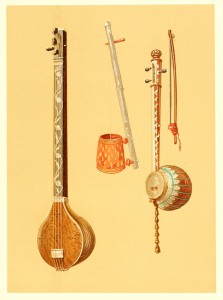TAMBURI. YEKTAR. PERSIAN SITARA.
THE Tamburi shown to the left of the plate is used as a common accom-
paniment to singing, the strings are never stopped, but are alwaj-s
struck open by the fingers, which in this case are not armed with
plectra. In outer form the Tamburi much resembles the vina, but is less
complicated, having no frets or calabash affixed to the stem ; and it is employed
for accompaniments only.
The Yektar, or Tuntuni as it is sometimes called, shown in the centre of the
plate, can hardly be called an instrument at all, since it has only one string
and no frets.
The three-stringed instrument to the right of the plate is the Persian Sitara.
Its use in India is very uncommon, but it is sometimes met with in large native
cities, such as Hyderabad or Jeypur, where it is admired chiefly as a variety. The
body of the specimen drawn is of wood, ornamented with ivory, the back of the
instrument being left open. As can be seen, the belly is of parchment, and the
tailpin, which serves as a foot for the instrument, is of brass, rather curiously
worked. There are usually three gut strings, tuned like those of the sarangi,
and played by means of a bow.

